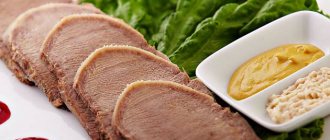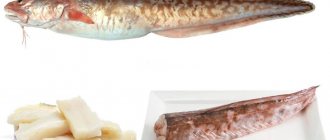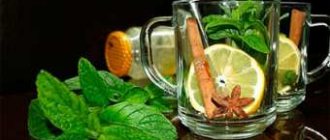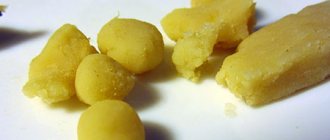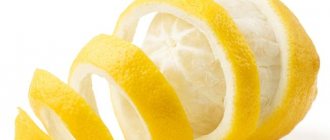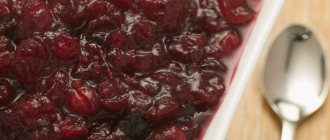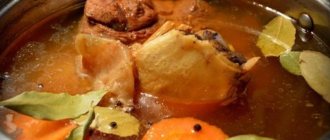Béarnaise sauce (or simply Béarnaise) is a tasty, versatile and quite fatty sauce that is served paired with almost any type of main course. It is customary to pour sauce over all types of meat (poultry, fish, etc.). It perfectly emphasizes the taste of vegetables and even scrambled eggs. Served both hot and cold. It has a number of contraindications for use. In its taste characteristics, béarnaise is very similar to hollandaise sauce, so in some dishes these two fillings can be interchanged.
Composition and calorie content of béarnaise sauce
The standard composition of béarnaise sauce includes the following ingredients:
- white wine vinegar;
- fatty and as natural as possible butter;
- raw yolks (preferably from domestic eggs);
- shallot;
- a set of spices: tarragon, chervil (similar to parsley), black peppercorns, etc.
Modern chefs like to experiment with the spices that make up the sauce, and also supplement it with various vegetables. The composition of the gravy directly depends on the dish with which it is served.
The calorie content of bearnaise sauce per 100 g is 321 kcal, of which:
- Proteins - 3 g;
- Fats - 34.1 g;
- Carbohydrates - 0.6 g;
- Dietary fiber - 2.9 g;
- Ash - 0.4 g;
- Water - 37.1 g.
The ratio of proteins, fats and carbohydrates is 3%/95%/0%, respectively.
Vitamins per 100 g of product:
- Choline - 132.2 mg;
- Vitamin H - 9.3 mcg;
- Vitamin E - 0.8 mg;
- Vitamin D - 1.3 mcg;
- Vitamin C - 2.6 mg;
- Vitamin B12 - 0.3 mcg;
- Vitamin B9 - 4.3 mcg;
- Vitamin B6 - 0.08 mg;
- Vitamin B5 - 0.7 mg;
- Vitamin B2 - 0.08 mg;
- Vitamin B1 - 0.04 mg;
- Vitamin A - 400 mcg;
- Vitamin PP - 0.03 mg;
- Vitamin A - 0.4 mg.
Minerals in 100 g of product:
- Cobalt (Co) - 4.2 μg;
- Boron (B) - 11.6 μg;
- Molybdenum (Mo) - 5.1 μg;
- Fluorine (F) - 0.7 μg;
- Chromium (Cr) - 1.2 μg;
- Manganese (Mn) - 0.0219 mg;
- Copper (Cu) - 47.3 mg;
- Iodine (I) - 5.5 mcg;
- Zinc (Zn) - 0.5764 mg;
- Iron (Fe) - 1.3 mg;
- Sulfur (S) - 33.8 mg;
- Chlorine (Cl) - 1684.5 mg;
- Phosphorus (P) - 98.3 mg;
- Potassium (K) - 37.2 mg;
- Sodium (Na) - 21.7 mg;
- Magnesium (Mg) - 3.5 mg;
- Calcium (Ca) - 40.6 mg.
On a note!
One teaspoon holds 10 g of sauce, and a tablespoon - 20 g. You can not only prepare the gravy yourself or order it at a restaurant, but also purchase it at the grocery store.
Most modern manufacturers package the sauce in 250 g jars.
Beneficial properties of béarnaise sauce
In theory, the benefits of bearnaise sauce for the human body are obvious - to understand this, just look at the list of vitamins and minerals included in the product. It is worth noting that in practice it is quite difficult to improve your health with this sauce, because it is served to the table in small quantities. To reap maximum benefits, it should be consumed regularly.
The main beneficial properties of béarnaise sauce:
- Strengthens the body, tones, improves the condition of the skin and the functioning of internal organs - the gravy contains tarragon, rich in ascorbic acid, beneficial nutrients, resins and more.
- Protects against viral diseases - antimicrobial and immunomodulating substances get into the sauce from the same tarragon.
- Quickly creates a feeling of satiety - the gravy includes a large amount of butter and is quite high in calories. Bearnaise will make even a vegetable salad satisfying, because 95% of the sauce is fat.
On a note! If you buy ready-made sauce in a store, take a close look at its appearance - the product should have a fluffy, thick consistency and a smooth surface. Also, there should be no lumps in it.
Adapted recipe for béarnaise sauce
- onion – 60 g;
- apple cider vinegar (6 percent) – 100 ml;
- chicken egg yolks – 2 pcs.;
- butter – 0.24 kg;
- water – 20 ml;
- ground black pepper – 5 g;
- tarragon - 3 sprigs;
- thyme – 1 sprig;
- bay leaf – 1 pc.
Cooking method:
- Remove the skin from the onion and chop it finely.
- Tear off the leaves of tarragon and set aside.
- Place onion, bay leaf, thyme sprig and tarragon stalks (without leaves) in a small container, add pepper. Pour vinegar over it all and place on low heat. Reduce the mixture by about half. Strain through a sieve.
- Beat the yolks, adding a spoonful of cold water and vinegar that has cooled to room temperature, infused with the aromas of herbs.
- Heat in a water bath. Add the butter in small pieces, whisking the sauce each time until smooth.
- When the oil runs out, add finely chopped tarragon leaves to the sauce, stir and remove from the water bath.
The sauce prepared according to this recipe has the same consistency as the original béarnaise sauce and a very similar taste, a little spicier. To obtain a milder taste and an even more pleasant aroma, some housewives replace part of the vinegar with lemon juice, but not more than half.
Béarnaise sauce, which has a delicate consistency and creamy taste, is an excellent addition to any dish; it complements the taste of lean meat and poultry especially well.
Considering that the original recipe requires products from Bearn - the southern region of France, where the name comes from - we take the risk of reproducing it, adapting it to our area. Chicken eggs, butter and basic spices are close to a common denominator everywhere, but wine, vinegar and herbs will become variable quantities, replaced by similar ones.
We follow the sequence of actions and maintain the temperature of the water bath in the region of 60-80 degrees. When lowered, the Béarnaise sauce will not thicken and will remain liquid. Conversely, if the boil is too active, it will curl into an omelette.
Béarnaise is good to serve both cold and hot. The sauce is often prepared in advance and kept in a sealed container on the refrigerator shelf for a couple of days, reheated if necessary. It's up to you whether to baste fish, meat, chicken, or dip bars of raw, steamed, baked vegetables and root vegetables, bread, and crackers.
Cooking time: 30 minutes / Number of servings: 2-3
Contraindications and harm of béarnaise
Gastroenterologists and other medical specialists focus on the dangers of béarnaise sauce for certain categories of consumers - béarnaise is strictly prohibited for consumption by people suffering from gastritis and ulcers
. This prohibition is due to the large amount of tarragon included in the sauce. This seasoning increases the acidity level in the stomach.
Pregnant women should also avoid béarnaise sauce.
, otherwise a large amount of this seasoning can cause a miscarriage.
Be careful, the sauce quickly becomes unusable - consuming a sour product can cause indigestion and other gastrointestinal problems.
Béarnaise can be stored in a room with average air temperature for no longer than 36 hours. To extend the shelf life of the sauce, place it in the refrigerator - here the seasoning will last up to 3 days.
If you decide to store the filling in the refrigerator, keep in mind that before serving it should be heated in a water bath, because due to the cold it hardens and acquires a too thick consistency.
Little secrets
- Béarnaise sauce can be stored in the refrigerator for up to two days.
- If after storage you want to serve the sauce warm, you can only heat it in a water bath, otherwise it will separate.
- If your sauce still separates, add an ice cube and whisk. The seasoning ingredients must be recombined.
French cuisine is famous for its large number of different sauces. Some of them are prepared for specific dishes, others perfectly complement the taste of several dishes, and others are universal or almost universal. Béarnaise sauce belongs to the third group. Most often it is served with meat and poultry, but it harmonizes no less well with fish, seafood, and vegetables. The versatility of béarnaise sauce also lies in the fact that it is good both hot and cold. However, it must be taken out of the refrigerator in advance so that it warms up to at least room temperature, since otherwise its consistency will be too thick and it will be difficult to pour it over the dish. The sauce itself is quite thick and fluffy, and has a pleasant creamy tint. It is prepared on the basis of white wine vinegar, butter and raw yolks, with the addition of a certain set of herbs and spices that give the liquid seasoning a unique taste and aroma.
How to make béarnaise sauce?
Almost all cookbooks note that béarnaise has an average degree of difficulty in making. Absolutely every cook should know how to prepare bearnaise sauce, because this filling is universal in use, it will come to the rescue when there is no time to prepare more complex sauces.
Step-by-step recipe for béarnaise sauce:
- Mix 1 tsp. white wine vinegar with 1 tsp. dried onions and an assortment of herbs you like, be sure to include tarragon and chervil.
- In a separate bowl, beat 4 yolks.
- Melt 250 g of butter and gradually add it to the yolks.
- Mix the mixture of yolks and butter thoroughly, and then add vinegar and spices to it.
- The sauce is almost ready, season it with salt and pepper to taste. After this, serve immediately paired with the main course. Bon appetit!
A few simple rules that every cook should remember before starting to prepare béarnaise:
- Use eggs from domestic chickens, because their yolks have a richer and brighter color, thanks to which the sauce takes on an appetizing shade. They also need to be washed before use to avoid contaminating food with salmonella.
- According to the standard recipe, shallots are used to prepare the sauce. If you don’t have this ingredient, don’t be upset and replace it with another type of onion; this will have virtually no effect on the taste of the sauce.
- Do not substitute red wine sauce for white wine sauce; this will change the original color of the sauce. If you don't have the type of vinegar you need, use apple cider vinegar as a substitute.
- Do not replace butter with spread, margarine and other similar products. In this case, butter plays an important role and is considered one of the main ingredients of the sauce. Therefore, without butter, béarnaise will not taste good.
- If you don't have chervil, feel free to substitute it with parsley - both ingredients have a similar taste and aroma.
- Add the ingredients into the sauce gradually, rather than all at once. Otherwise, the consistency of the product will be incorrect.
- If the gravy still doesn’t come out, for example, it has separated, try to fix it with pieces of ice. Add them to the sauce and beat the mixture thoroughly using a blender. You can also add the yolk to the finished gravy and strain it.
Interesting! It is worth adding only 1 tbsp to béarnaise. l. strong broth on the meat, and you will get a completely different dressing - Valoise sauce. This seasoning is served with chicken and eggs.
What is it served with?
Béarnaise is one of the five best French sauces and belongs to the category of universal dressings. It goes equally well with both meat and fish dishes.
In its historical homeland, béarnaise sauce is used to season cauliflower and asparagus dishes and is also served with T-bone steak. "Béarnaise" is a rather refined addition to seafood dishes, an amazing gravy for eggs "Benedict", and it also goes well with hot sandwiches.
The list of ingredients in the recipe is quite large, and the process of making the sauce is a complex culinary operation that requires following the instructions provided below.
- For example, if during preparation of the seasoning the oil is not brought to the required temperature or is overheated, or if the ingredients are not entirely fresh, the sauce may be hopelessly spoiled.
- If the dressing has curdled, you can add a little water or one yolk to it. Beat with a mixer or rub through a sieve.
- If there is no bottle of white wine in the house when preparing the sauce, experienced chefs recommend replacing it with red wine; the taste of the prepared seasoning should not suffer from this step.
- In order to prevent the mixture from sticking to the walls of the bowl when whipping it, it is necessary to temporarily remove the container with the sauce from the heat and allow it to cool much. Then return to the process.
- The seasoning is best served warm.
The classic recipe has something in common with an equally famous sauce from France called Hollandaise. But with significant deviations for taste. According to the recipe, unlike hollandaise sauce, you need to add tarragon and shallots to bearnaise sauce. When preparing Hollandaise, lemon juice is enough.
The sauce is high in calories, so it should be consumed in moderation. However, the taste of the seasoning is so delicious that, despite various food restrictions, it must be prepared and tasted in any case.
Recipes for dishes with béarnaise sauce
Add sauce to meat and vegetable dishes to make them more sophisticated and as close to restaurant-quality as possible. We present a selection of the simplest dishes involving béarnaise:
- Spicy pork with béarnaise
. To prepare this dish you will need 2 selected pork tenderloins, the total weight of which should be approximately 800 g. Clean the meat from fat and other unnecessary elements and cut into medallions. Each piece of pork should be no thicker than 2 cm. Season it with salt, generously sprinkle with pepper, then leave it alone for a few minutes. Fry green beans (you can use fresh or frozen). To do this, use only butter. A few minutes before it is ready, add 1 tbsp. l. butter and 2 grated cloves of garlic. Heat the resulting mass well. In a separate frying pan, fry the meat (in butter). Monitor cooking carefully to ensure pork is fully cooked but not too dry. Serve the medallions with the beans and plenty of béarnaise sauce. - Beef with bearnaise sauce
. Wash and dry 1 kg beef tenderloin. Divide the meat into small pieces (make sure they are not too thick, otherwise they will not cook through). While slicing, try to move the knife across the grain. Beat the resulting langets, season them with salt and pepper, and place them in a heated frying pan. Fry the meat in olive oil (a few minutes on each side). Meanwhile, prepare the béarnaise. For this meat you should prepare a sauce according to a special recipe. Boil all the spices in a shallow pan, soaked in white wine (75 g) and 1 tbsp. l. water. To do this, use black peppercorns, nine percent vinegar (1 tbsp) and always 1 tsp. dry tarragon. Don't forget the onions, cut into small pieces. Cook the mixture until it reduces by half. When the solution is almost ready, pour in 3 egg yolks, whipped into a foam. Be especially careful at this stage of cooking, as the yolks may quickly curdle. To prevent this from happening, stir them with a whisk all the time. Then add 0.5 tbsp to the almost finished sauce. melted butter and cook the mixture until it thickens. Remove the sauce from the heat and strain. Add some green parsley and red pepper to it. Now pour the sauce over the already cooked meat and serve the dish! - Artichokes with béarnaise
. To prepare this dish you will need a minimum amount of ingredients: just ready-made béarnaise, a few artichokes (4-5 pieces), half a lemon and some water. So, remove the bottom petals from the artichokes. Remove them until petals with a light-colored bottom appear. Make sure that there are no spiked petals left on the head. You should not completely cut off the artichoke stem, you should leave about 2 cm or a little more. Remove the top layer of skin from the stem. Bring a small amount of water to boil and add half a lemon to it. Immerse the artichokes in boiling water and cover with some kind of weight so that they do not float, but remain completely covered with water the entire time. Cook the artichokes for about 40 minutes, remembering to remove any foam that has formed. Please note: the artichokes are done when the petals almost fall off the stem. Wait for the ingredients to cool slightly and serve them with béarnaise sauce.
Please note that there is a certain technology for eating artichokes. Each petal must be dipped in the sauce and the soft part scraped off with your teeth; this is what is edible. However, you should not eat the petals themselves. When the petals are gone, you should be left with the so-called core in your hands; you can eat it entirely, except for the part on which the hair-like fibers are located. These fibers can be easily removed with a spoon.
On a note! If you need to reheat the béarnaise sauce, do not use the microwave for this, otherwise the sauce will separate and lose its fluffy, uniform shape. Professionals advise heating the product in a water bath, but not too hot.
Practical part
You need to start preparing béarnaise sauce with greens. To do this, carefully remove the leaves from the parsley and chervil. Then chop them and place them on saucers. Crush the peppercorns with a spoon or knife.
Cut the onion into rings and finely chop the mushrooms. Then you should pour the prepared alcoholic drink into a medium-sized bowl and add all the pre-crushed ingredients of the sauce inside. Next, you need to bring the contents to a boil, remove from heat and let cool. While the prepared mixture is cooling, you should work on the eggs. The whites must be separated from the yolks and the ingredients placed in different dishes.
Next, melt the butter. The cooled spice-wine mixture with herbs must be poured into the bowl with the yolks through a sieve. Then you should use a water bath. Take another container and heat water in it. Place the bowl with wine and yolks in a water bath and begin whisking the contents, bringing it to a creamy consistency. During the heating process, with constant whisking, the volume of the contents should double.
Continuing the whisking process, slowly and in a thin stream, add melted butter to the sauce being prepared. Wait 5 minutes and add chopped onion, a pinch of pepper, and salt to the seasoning. The sauce is ready to eat.
You can store it at room temperature for 1-2 days, in the refrigerator - up to 3. If the dressing was in the refrigerator, it must be slightly warmed before use, otherwise it will be very thick. When using the components in the specified proportions according to the recipe, you get a sauce that is enough for 4-5 servings.
Béarnaise sauce is a variation of one of the five main sauces of French cuisine - hollandaise sauce. It bears the name of the province of Béarn in the south of France, the birthplace of the French king Henry of Navarre, a famous gourmet. However, it would be a mistake to say that this dish was invented by Henry or someone at his court.
The sauce was created much later than the reign of Henry the Fourth - in the thirties of the 19th century. History has not preserved the name of the master who invented such a culinary masterpiece. But the original recipe for the seasoning has been preserved, which has been perfecting poultry and veal dishes for two centuries.
France is generally rich in sauces and seasonings. And this is no coincidence. The same meat or vegetables, sprinkled with different sauces, will have a completely special taste. A good sauce can also “hide” a cook’s mistake and save a seemingly lost dish.
The sauce we will prepare today is considered a classic in France. It is served with lean meats of various cooking methods. In modern cooking, it is also added to meat-based sandwiches. But this is already the influence of American cuisine. Today we will try to cook according to the classic recipe.
Interesting facts about béarnaise
For the first time, béarnaise was prepared by a French chef, but historians find it difficult to answer in what year this happened. The name of the sauce is consonant with the name of the city of Béarn, where one of the kings of France was born. Among modern chefs and gourmets, the sauce is still very popular as at the time of its invention.
How to make béarnaise sauce - watch the video:
Béarnaise sauce is a real storehouse of vitamins and minerals that the human body needs for healthy functioning. People with high stomach acidity should avoid spicy and fatty products. Béarnaise can turn any dish into a culinary masterpiece, and it is prepared quickly and easily.
